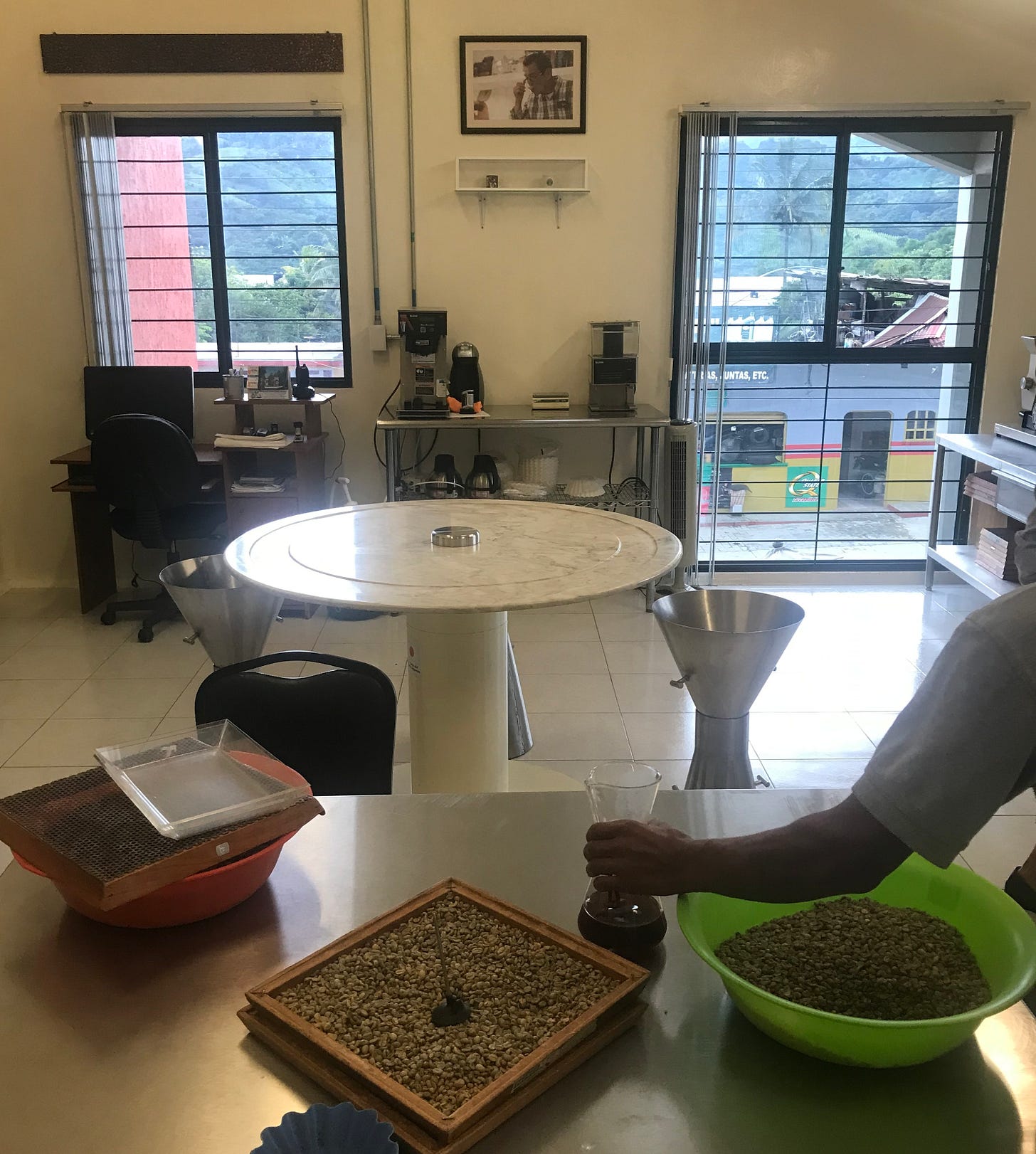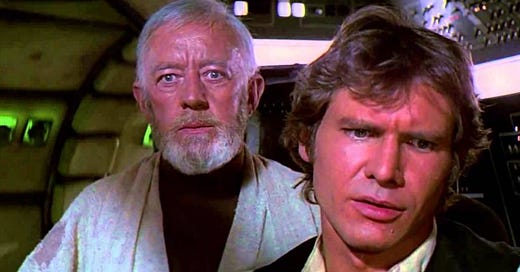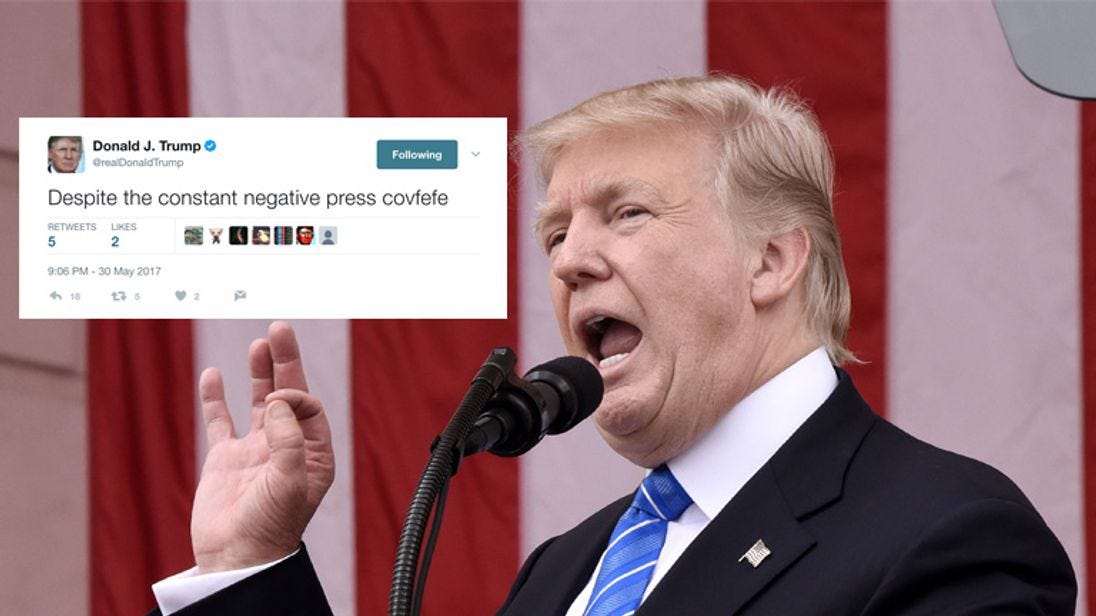On Colombian covfefe and a hot farming future
It's not Trump's behavior or typos that should concern coffee's long term role in your life. A realistic review of domestic coffee growth.
My new poetry collection These Empires, These Flowers is coming out in April 2025! If you like my writing here, you might enjoy my poems. Reply to this email or message me to pre-order.
I love coffee like I love the moon. I know it’s wonderful, a companion not at night but in the morning, but one that, any day now, can be blown up a la Alderaan by the Death Star. It’s not always going to be there.
Blame David Sedaris’s recent entry into my diet for the silliness. The moon will probably be there tonight. For what else will crunchy van-dwellers on the west coast write poems? Star Wars fans will slap my hand for the mixed metaphor, too. The Death Star is itself confused for a moon by old man Obi Wan Kenobi.
Like that legendary revelation, a funny hoodwinking just played out for even the most casual of coffee drinkers. And, like the temporary nature of something as hopefully permanent as the moon, the truth is more sinister.
Donald Trump just encountered covfefe for the first time in his second presidency. To be fair, that’s only true in a cursory way; as Joseph Nevins documented in “Dying for a Cup of Coffee? Migrant Deaths in the US-Mexico Border Region in a Neoliberal Age,” anti-immigration policy to the United States does have a reverse impact on coffee farming communities in Central and South America. To the point, though, Trump had a now-resolved spat with Colombian President Gustavo Petro over airplanes.
The quick and dirty, per BBC, sees the two politicos sparring over Trump’s decision to fly migrants into Colombia. Two military cargo flights coordinated were denied entry on Sunday, January 26. Trump and Gustavo puffed chests online, declaring “emergency” tariffs as high as 25 and 50 percent against each other, according to Axios. By Monday Gustavo yielded, or someone in his government ironed out the plane landing on his behalf; Trump claimed victory, and life goes on.
But! This circus — part of what Littlefinger-esque Stephen Miller calls “flooding the zone” upon taking over the White House, confusing and scrambling opponents — entered the coffee world. That’s because Colombia is the fourth-largest coffee producer in the world. Moreover, Colombia relies on imports to its caffeinated cousin to the north, “with over $39 billion in goods and services traded between both countries in 2022, according to the U.S. State Department.”
Online communities rioted over the weekend. A Bluesky search elicits users “reality check 🤔🤷♂️” writing “Now Colombia is going to pay 25% of the cost of your coffee! Wait... That's not right? I could have sworn Trump told me it works that way.” and “Joel Klebanoff” adding “I think the 25% (later 50%) tariff on Colombian goods is a great idea. Americans may respond by buying less Colombian coffee. That'll reduce total demand, which should lead to lower prices in Canada (and elsewhere). It's the patriotic thing for Americans to do. Oh, did I mention I'm Canadian?”
Tl;dr, for a weekend in late January, it looked like Colombian coffee could be way more expensive.
Here’s where the plot twist strikes at the end of act one. In the event Trump’s tariffs took hold, or do take hold — something I touched on regarding an American wake — indeed coffee from that country will be more expensive. Your local grocery store, conglomerate behemoth branch or not, will pay more for the beans, and that cost gets passed on. It’s a question I’ve wondered a lot since the election: if voting red to bring prices down, from eggs to car parts, wouldn’t one take the time to learn about tariffs?
A devotee may reply: I do understand tariffs! By penalizing domestic buyers, it promotes economic development with countries that will bend the knee, or, better yet, fuel industry in-country.
This thinking does not map to coffee. There is domestic U.S. production in Hawai’i — an afternoon spent visiting the wine country-esque boutique farms on the Big Island is enchanting — but it is not enough to meet the somehow still-growing demand for coffee. Though Drift covered California-grown coffee in its 2021 Los Angeles issue, players as eyebrow-raising as singer-songwriter Jason Mraz entering the fray, it doesn’t take an economist to look at that nascent market and pause: the very, very little coffee grown in Southern California, greenhouses in Santa Cruz, or wherever you may spot a sapling, can cost some $26 U.S. per cup.
This is where “that’s no moon” enters stage left. Tariffs on Colombia, tariffs on Vietnam, wherever else Trump may weigh his thumb, is not the planet-exploding power his acolytes crave. Climate change has already excaberated coffee as a market, and this last year was one of the most depressing examples of that devastation.
In coffee circles, the almost 50-year high for commodity coffee prices, more than $3.30 per pound for arabica futures, was well-discussed last year. On Map It Forward, Indian coffee producer Komal Sable recounts how processing her farm’s coffees was erratic and challenging thanks to bizarre weather patterns.

That tracks. The New York Times reported in December 2024 “repeated droughts and flooding have strained the global supply of coffee, frequently causing prices to soar, as climate change has done for other staples, like cocoa, olive oil and orange juice.” Brazil and Vietnam, first- and second-largest coffee producers, experienced major floods and droughts causing those prices to soar. Kevon Rhiney, an associate professor at Rutgers University who researches coffee production, told the Times “In some ways, this is a sign of what is to come…The areas that are suitable for making coffee will shrink over time.”
I insist on this false moon comparison. I insist because trade wars with Colombia or any other country couldn’t guarantee all the coffee in the world for greedy, cheapskate U.S.-based drinkers. Only addressing climate collapse would, and even then, it’s a long shot. That’s no trade war, Kenobi might mutter, that’s political theater.
Agroecological practices might actually provide a more stable coffee landscape. A book I’ve referenced before is mighty relevant today: Cheap Coffee: Behind the Curtain of the Global Coffee Trade was written by Colombia-based coffee pro Karl Wienhold. He has a grasp on what’s going on: it’s not just better buying practices or “fair trade” that will save coffee. A lot of tactics will need to be not just pioneered but brought to farmers; Wienhold identifies the populations of birds in a growing area , for instance, as one of the biggest KPIs of healthy coffee resilience.
When I worked in Chiapas for about a month, traversing the hilly Zapatista communities, I experienced first hand how hard it is to convey such information to agricultural areas. Try bringing a laundry list of organic-growing practices to a 60-year-old abuelo growing coffee for the third generation in his family. He’ll laugh you right off the hill.
Thankfully these communities have known how to grow crops without U.S. intervention, long before the U.S. was a country. I remember one man I interviewed detailing bee apiaries he and his kids work on the outskirts of Chilón. He almost didn’t get what I meant as I subjected him to a battery of questions regarding biodiversity and economics. Of course there are no chemicals on the bees, he said, of course we work to bring the birds back to our trees.
It’s no moon, reader.
Coffee will go away, obliterated not by the #Drumpf, Cheeto Man but by us, all coffee drinkers who buy the crappy stuff, who are tricked by tariff talk and stupid news cycles. Here’s an econ 101 lesson a Trump voter could get behind: Coffee prices are going up because there’s less coffee supply. There will be less and less supply because the world is getting too hot to grow more. Pivoting toward synthetic coffee is fine, but as goes for lab-grown chicken, it actually won’t solve the problems we’re discussing.
There are outcomes, maybe in my life time, where coffee can be grown in long-time consuming countries. The United States could get behind this idea; the U.S. Department of Agriculture under George W. Bush created the Tobacco Transition Payment Program President to help farmers cycle off the federal quotas guaranteed, pivoting off the deeply unethical, less and less popular crop. Maybe, as Phoenix reaches the triple digits every year, shit will get so hot the coffee belt will migrate north, like many of its denizens themselves headed north only to be flown back as military cargo.
But that’s no moon, too. As long as WEIRD countries — Western, educated, independent, rich, and democratic, as penned by Joseph Hinrich in The WEIRDest People in the World: How the West Became Psychologically Peculiar and Particularly Prosperous — continue turning toward populism in the early 21st century, then it’s all just one big powderkeg waiting to blow. The wealthiest man on the planet, the WEIRDest nepo baby who ever lived, is out here telling Italians and Germans they need to wind the clock back to the 1940s. And people fucking love it.
Goodnight, sweet Alderaan, and goodnight morning covfefe.





